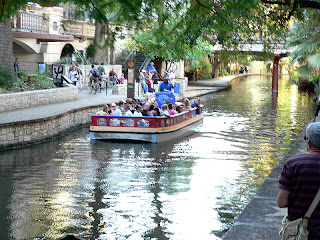We chose the Laura Plantation for our plantation tour. River Road between New Orleans and Baton Rouge along the right bank (North) of the Mississippi River was the sight of hundreds of plantations in their hey dey - cotton and sugar cane crops.
Our Bus Driver / Guide was very knowledgeable about the NO area and in particular the Creole peoples and their culture. He very eloquently talked non-stop on the drive to and from the plantation. At one point we worried that he was not paying enough attention to his driving - but we survived!
The Laura Plantation is special as archivists discovered the memoirs of a descendant of the original Creole family who built and farmed the sugar cane (white gold they called it) crop on this plantation. Four generations of this founding Creole family worked this plantation from 1805 to 1892 - when Laura (wanting to escape the Creole plantation lifestyle) sold out to a German family. Laura's Father named the property after her in an attempt to soften her resolve to leave and entice her to remain and manage the business. It didn't work. She not only left, but she married a Protestant out of St. Louis to boot! Laura wrote her memoirs in the mid 1930's when she was 74 years old - mainly out of a desire to preserve an accurate account of Creole plantation life and culture and to clarify misconceptions prevailing at the time with the filming of "Gone With the Wind". Laura died in 1963 at the ripe old age of 102! Her memoirs were not discovered for another 30 years - but now provide valuable insight to the restoration of the original buildings that are open to the public.
 |
| A home in the midst of swamps and marshes - as we were driving to the plantation. We saw this as we first entered the NO area as well. The beginning of 'lots of water'. |
 |
| Interstate 10 over and above the Bayou's, swamps and marshes! |
 |
| One of only about 8 plantations still in existence along River Road that is being restored. |
 |
| A copper pot used during the sugar cane harvest to reduce the sugar can into marketable product! |
 |
| Laura Plantation "Great House" - Corporate Headquarters. There are no hallways in a Creole house - just rooms with doors leading from one room to the other. A bank of rooms is on the front and a bank of rooms is on the back. The kitchen is not a part of this main structure - but set back at the rear in separate buildings - for fire safety reasons. Monsieur Deparc commissioned the services of a skilled Senegal Slave to design and build this house - it took one year to lay the foundation and base for the house - a series of 72 columns placed on pyramid type columns that were imbedded in the unstable alluvial soil. Then other slaves were sent into the forest to cut the required sizes of cypress beams to assemble the top structure - brick within cypress beams - and this part of the construction took only 11 days! Cypress is impervious to water and termites - hence the longevity of this home. But Formosan termites apparently will attack the cypress, so these little pests are being exterminated where possible. We did notice metal plates flush with sidewalks in front of buildings - and those are apparently the Formosan termite traps! Sadly the Cypress was clear cut back in those days - reforestation was not practiced 200 years ago. We asked and yes they are planting new forests of Cypress, but it is a very slow growing tree apparently. |
 |
| An ancient oak in front of the Laura House. these oaks served an important function - running in a row down to the river with a wagon road in the middle - they provided shade and an avenue for the river breezes to blow up to the Great House - where they then opened the Breeze doors along the front verandah to allow the cooling breezes into the house in the heat of summer. |
 |
| A bonfire pier in front of the Laura House. Back in the 1700's and 1800's every plantation would construct a bonfire pier like this in front of their property on the banks of the Mississippi - and then on Christmas Eve all the fires were lit - quite a spectacle up and down the river with a huge bonfire every mile or so for hundreds of properties!!!! |
 |
| A earthen vessel like what would have been used at Laura. The outside is not glazed - as this vessel would be buried in the ground - up to where the neck is glazed - and this served as a cooling vessel for food stuffs. This vessel is valued at $6,000 |
 |
| Creole family members and descendants of the founding family. They were very fortunate to have retrieved these valuable pictures along with the detailed memoirs and other artifacts gracing the prpoerty! |
 |
| A fire did start on the property a few years ago - but they were able to salvage the property. Here one can see the structural design - brick between Cypress Columns. They removed gyproc to expose the original structure. The gyproc does protect the brick from deteriorating in the heat and humidity. |
 |
| The original brick patio behind the Laura House - and in the background is where the series of kitchen buildings would have stood back in the 1800's |
 |
| The back verandah of Laura with a shot of a Breeze door. |
 |
| Innovative use of wine bottles to warm the soil in the herb garden. One of the business ventures the women practiced was to import Bordeaux wine from France (they had contacts) - and which they then sold for a handsome profit from the Great house. As an example of their wealth back then - one of the Daughters had a dowry that would be $20 M by today's standards. Creole women started out independently wealthy! |
 |
| Banana trees out behind the Great House - there would have been massive gardens in its hey day - to support and feed not only the family members but the 186 slaves on the property. |
 |
| This bell would have been used to summon the plantation workers (slaves) and family members to meals. Slave children starting at age 5 would walk up to the kitchen with a pail each to collect food to take back to their families slave cabin. |
 |
| One of the original slave cabins on the property. They were required to provide a 8' X 16' cabin for each slave family - the family then innovatively built duplex structures 8' X 32 ' to house two families each. The Creoles adhered to an established code of ethics in the management of their slaves. They attached value and status to their slaves depending on the skill set that a slave may possess (the housebuilding slave from Senegal would have had a very high value at the time). We asked if the Creole treatment of slaves was better than that other Southern American Slave owners. The answer was "not necessarily better - just different". And interestingly - when the English speaking (and Protestant) Americans started moving in and bringing their slaves with them - there was considerable distrust and animosity not only between the Creoles and the Americans but between the Creole owned slaves and the American owned slaves as well! |
 |
| The retirement home of one of the family Matriarchs who, when she retired from the management of the plantation - had to move out of the Great House. She refused to move into town so this home was built for her on the grounds. Apparently- not totally ready to let go of the reins, she tried to continue firing out orders to the workers from her walkway balcony - which has since crumbled. The plan is to restore the building as well. |
The Laura property was only about 3/4 of a mile wide - fronting onto the Mississippi - and 12 miles deep (12000 acres) - the French Colonial method of parceling out the land. Everyone had to have a river front - as the river was the 'highway' of the day - the main mode of shipping and receiving goods! The restored main house dates back to 1805 - over 200 years old!
The Creole lifestyle was very different from the American lifestyle in other Southern regions like Alabama or Tennessee. For example (sorry guys!) the business in a Creole family did not automatically pass to the eldest son but to the 'smartest' child - and at Laura - that meat 3 generations of women heading up the corporation - and they managed the business with a shrewd skill. Creole women had rights - they could do banking, sign contracts etc etc. Rights not enjoyed by women elsewhere in the country in this era.
At the height of its operation the Laura Plantation had 186 slaves. The main house served as Corporate Headquarters - and everyone who lived in the big house had to be a participating family member in the business or else move out. The Creoles worked hard and played hard. After the harvest was in and after Christmas but before Lent, they would leave the farm and move into the city (New Orleans) to their town house - and there would begin 2 to 3 months of socializing, partying, singing, eating, dancing and it would be at this time that the young women or "Debutante's" would have their coming out appearance - then the courting would start! The pictures will fill in some blanks!































































